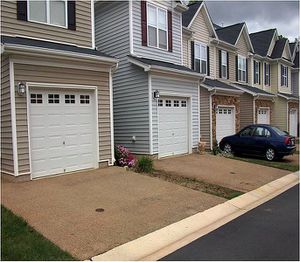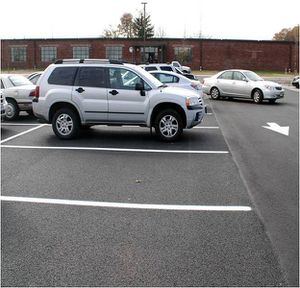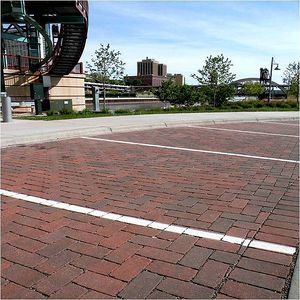
The anticipated construction period for this page is January through March, 2013
The anticipated review period for this page is January through March, 2013
Permeable pavements allow stormwater runoff to filter through surface voids into an underlying stone reservoir where it is temporarily stored and/or infiltrated. The most commonly used permeable pavement surfaces are pervious concrete, porous asphalt, and permeable interlocking concrete pavers (PICP). Permeable pavements have been used for areas with light traffic at commercial and residential sites to replace traditionally impervious surfaces such as low-speed roads, parking lots, driveways, sidewalks, plazas, and patios. Permeable pavement is not ideal for high traffic/high speed areas because it has lower load-bearing capacity than conventional pavement.
While the designs vary, all permeable pavements have a similar structure, consisting of a surface pavement layer, an underlying stone aggregate reservoir layer, optional underdrains, and geotextile over uncompacted soil subgrade.
From a hydrologic perspective, permeable pavement is typically designed to manage rainfall landing directly on the permeable pavement surface area. Permeable pavement surface areas may accept runoff contributed by adjacent impervious areas such as driving lanes or rooftops. Runoff from adjacent vegetated areas is often discouraged because sediment in runoff from adjacent areas increases clogging of the permeable pavement, especially at the edges. Additionally, the capacity of the underlying reservoir layer limits the contributing area.
The individual articles comprising this section on permeable pavement may be viewed as a single article.
Several fact sheets for permeable pavement provide overview information and information on design, construction and maintenance, and volume and pollutant removal.
While the designs vary, all permeable pavements have a similar structure, consisting of a surface pavement layer, an underlying stone aggregate reservoir layer, optional underdrains, and geotextile over uncompacted soil subgrade.
From a hydrologic perspective, permeable pavement is typically designed to manage rainfall landing directly on the permeable pavement surface area. Permeable pavement surface areas may accept runoff contributed by adjacent impervious areas such as driving lanes or rooftops. Runoff from adjacent vegetated areas is often discouraged because sediment in runoff from adjacent areas increases clogging of the permeable pavement, especially at the edges. Additionally, the capacity of the underlying reservoir layer limits the contributing area.
The individual articles comprising this section on permeable pavement may be viewed as a single article.
Several fact sheets for permeable pavement provide overview information and information on design, construction and maintenance, and volume and pollutant removal.


